Right plant, right place and sustainable grazing management leads to persistent pastures
Phalaris, tall fescue and lucerne pastures, when placed in the right part of the landscape and managed to minimum ground cover and feed on offer benchmarks, can persist through severe drought years on the southern slopes of NSW.
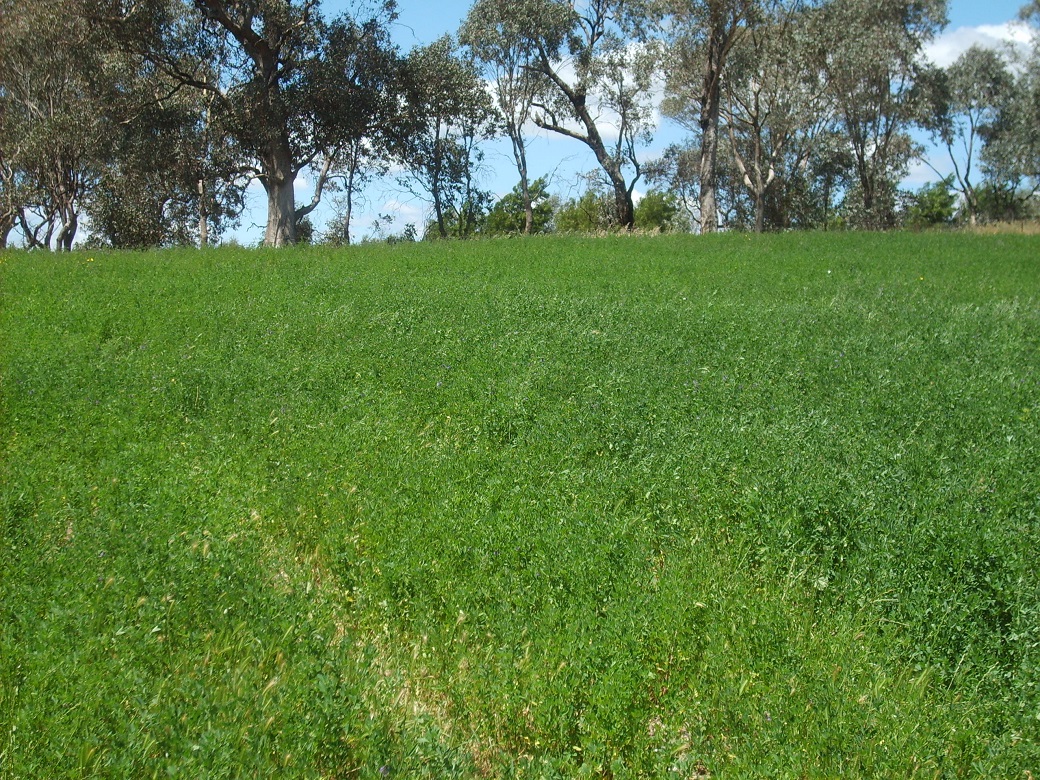
Main findings
- Perennial pastures established during a drought managed to persist, and subsequently improve after the drought, by correct species and cultivar selection and appropriate placement in the landscape.
- The persistence of the perennial pastures through several drought years was also attributed to appropriate grazing management and use of containment feeding when necessary.
- The annual grass content of pastures also increased over time and was similar in all livestock systems. Herbicides may be required to control barley grass seed in the lucerne paddocks to prevent animal health issues and provide quality lucerne for weaning lambs.
- Groundcover was maintained above 70% most of the time in all pasture types and with different livestock systems. Lower groundcover was more frequent in lucerne pastures during autumn.
Read more about this research
The opportunity
The south-west slopes of NSW, where annual rainfall is above 600mm, can sustain a number of perennial pasture species. Perennial pastures extend the growing season compared to annual pastures, providing opportunities for improved profitability and helping to minimise environmental risks.
Establishing perennial pastures can be expensive, often costing in excess of $350/ha. Generally, perennial pastures must persist for at least five years before these costs are recouped. The longer they persist and remain productive, the greater the return on investment. To achieve good persistence, it is essential to select suitable species and cultivars and place them appropriately in the landscape. Appropriate grazing management also needs to be applied for pasture persistence as well as to manage environment risks such as erosion and salinity.
What was done?
As part of the Wagga Wagga Proof Site located at Ladysmith in NSW, EverGraze researchers set up a number of ‘model farms’ to test four different livestock systems using a perennial pasture base of 20% lucerne, 20% summer active and summer dormant tall fescue mix and 60% phalaris. All cultivars were sown with mid-season flowering (Riverina and Coolamon) and late season flowering (cv. Goulburn) sub clover cultivars. Earlier flowering times protect against failure to produce seed in dry springs while later flowering times provide additional quality in good seasons.
The livestock systems were:
- The traditional July lambing system with all ewes joined to Merino rams.
- September lambing system joining half the ewes to Merino and half to terminal rams;
- Half the ewes lamb to terminal rams in July and the other half to Merino rams in September. A short (two week) joining to terminals was used in February for 60% of the ewes (although based on results three weeks is recommended), those that failed to fall pregnant and un-joined ewes were joined in April to Merino rams.
- High Lucerne, the same as the September lambing but with 40% of the farm area sown to lucerne, 15% fescue and 45% phalaris.
All systems used the same stocking rate (dry sheep equivalents) in July (time of most limiting feed) to enable a fair comparison. Grazing rules were established to maximise animal production, pasture production and pasture persistence. The persistence of perennials and groundcover levels (for erosion control) were evaluated to determine if the different grazing systems and grazing rules had an impact on pasture persistence.
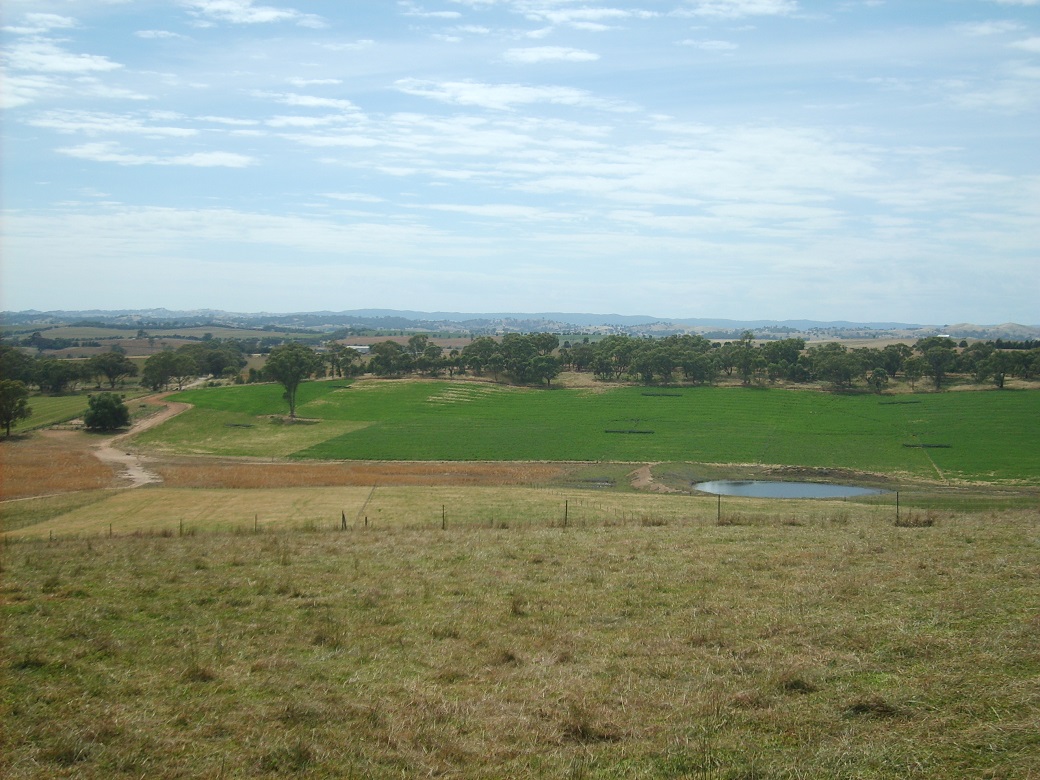
Pasture selection and place in the landscape
Within the southern slopes NSW region, the trial site is located near the western boundary of adaptation for most perennial grasses due to declining annual rainfall, and the eastern boundary of adaptation for lucerne due to increasing soil acidity and water-logging. To ensure pasture production and persistence were maximised, soil types were mapped prior to sowing (Figure 1) and pastures established on the most suitable soil type for each species. Figure 1 is an ECa map. Higher ECa is an indication of higher moisture with associated differences in soil type and topography.
In Autumn 2005, phalaris (cv Australian) was established on the slopes with rocky outcrops on red tenosol soils, lucerne (cv Aurora) was established on the mid slope on red chromosol soils, and summer active (cv. Quantum) and summer dormant (cv. Resolute) tall fescue mix was sown on the wetter lower slope on yellow sodosol soils. The placement of species, and the species used was also designed to increase water use, thereby minimising recharge (causing salinity) and water-logging.
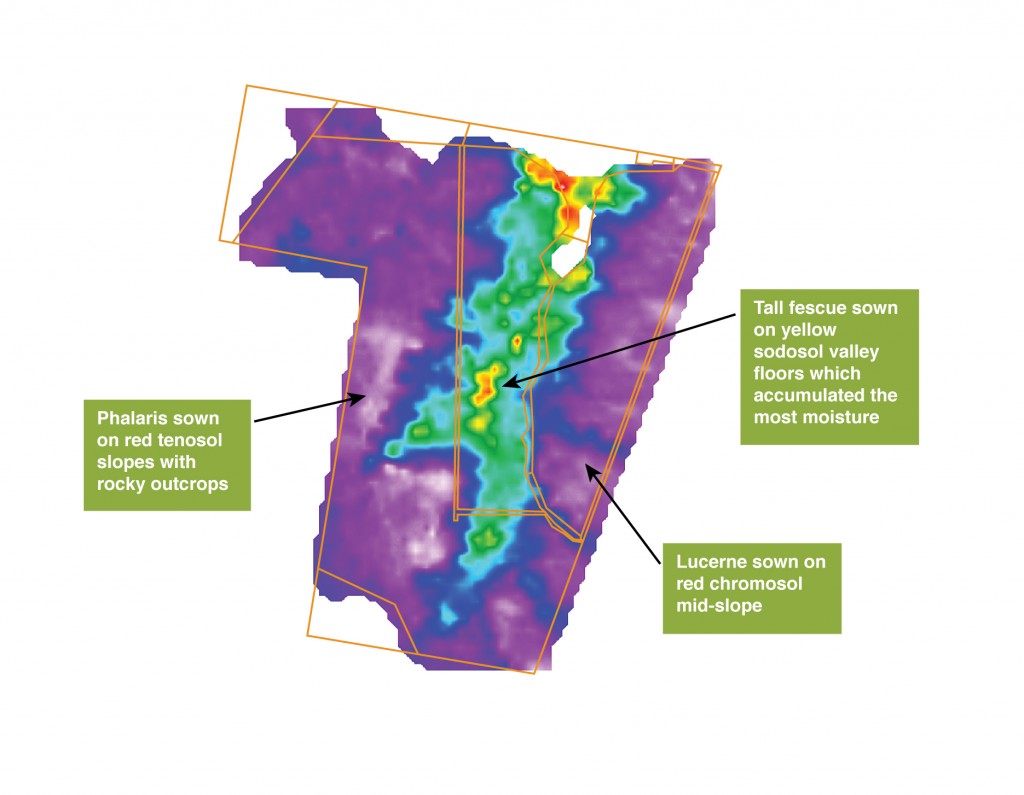
Australian phalaris has been the most common grass cultivar sown and reputedly the most persistent perennial grass species used in the region. In this region it can extend the available green feed by up to a month compared to annual pastures but it is largely dormant over summer. Lucerne cv Aurora is a winter active variety (dormancy rating 6) which has slower winter growth compared to annual pastures and the temperate grasses but is capable of producing and maintaining quality feed during summer if seasonal conditions are favourable. It is suited to parts of the landscape that are well drained and have a soil pH(CaCl) above 4.8.
Traditional tall fescue varieties are unsuited to areas with less than 650mm annual rainfall and frequently failed to persist for more than one or two seasons in this environment. However, cv. Resolute (Mediterranean type with mid-season maturity) and Quantum (Temperate type with early season maturity) are newer varieties that are potentially able to persist in areas with lower annual rainfall if appropriately located in the landscape. Both of these fescues are more tolerant of water-logging than either lucerne or phalaris, and while both will respond less to summer rain than lucerne, Quantum can have some summer activity (see Hamilton Proof Site message – Summer active tall fescue provides autumn feed in poorly drained soils).
All of the species sown are sensitive to, or intolerant of, acid soils (pH(CaCl) below 4.8) which are high in available aluminium. The site was previously limed to alleviate any acid soil issues. This is common practice in the region and considered an essential check when establishing pastures. Where subsoils have elevated aluminium levels, lucerne should not be sown.
Grazing management
While all of the sown pasture species have some preferred grazing management strategies to maximise pasture production and persistence, grazing management was not tailored to each species. For all livestock systems, ewes were moved as one mob to maximise utilisation. Pastures were grazed according to pasture availability and the capacity of the pasture to meet animal demands, while also trying to maintain groundcover above 70%. Sheep were removed from all paddocks when total feed on offer (live + dead) fell to below 500kg DM/ha (lucerne) or 1000 kg DM/ha (phalaris and tall fescue) to protect pastures, promote persistence, and prevent soil erosion. In spring, fescue was grazed harder to maintain feed quality, and lucerne was saved for finishing lambs. Persistence was measured by recording basal area. That is, the percentage of the ground occupied by the base or crown of the relevant perennial plant.
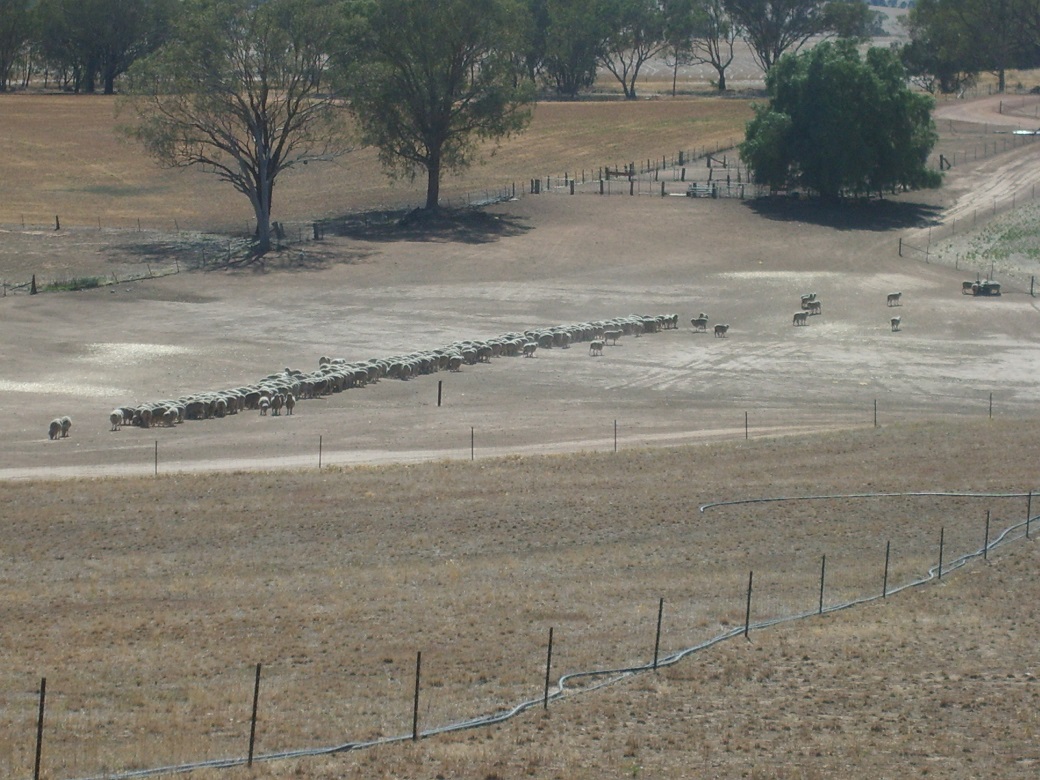
Seasonal conditions
Over the course of the experiment the site experienced a series of drought years followed by a very wet year (Figure 2). This provided particularly challenging conditions for pasture establishment and persistence and the results need to be interpreted accordingly.

What was found?
Good establishment
Pastures established well with plant densities after the first summer of 38, 26 and 51 per square metre, respectively, for lucerne, phalaris and tall fescue. Plants per square metre are not generally a good measure of plant persistence as it is difficult to identify individual plants after one or two seasons as plant crowns shift and merge into one another. Basal area measurements capture any changes in plant crown density and are a better longer term measurement of persistence.
Good persistence from good management
Basal cover increased from autumn 2006- 2011 for lucerne, phalaris and tall fescue pastures, although there were periods of decline in cover in both phalaris and fescue during the drought years (Figure 3). Post-experimental measurements show the basal cover of all pastures continued to increase eight years after establishment.
The persistence of the perennial pastures through several drought years was attributed to appropriate grazing management and the use of containment feeding when necessary. These rules reflect general recommendations for ground cover (>70%) and herbage mass benchmarks promoted by EverGraze and other flagship grazing training such as Prograze ™.
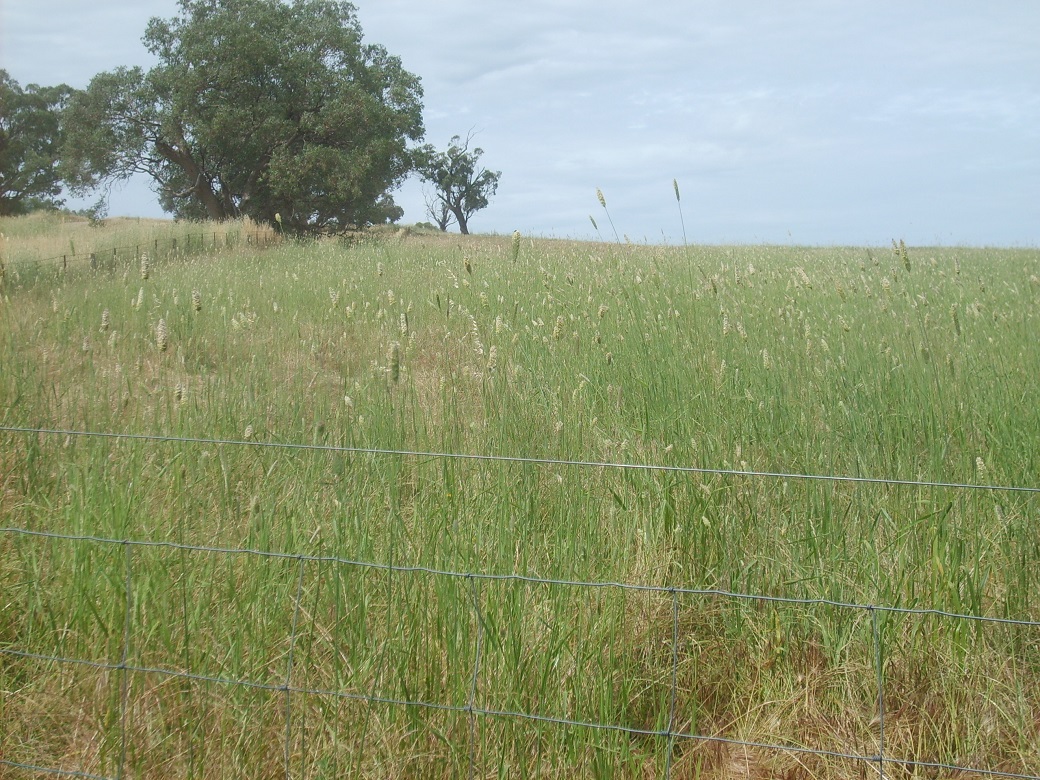
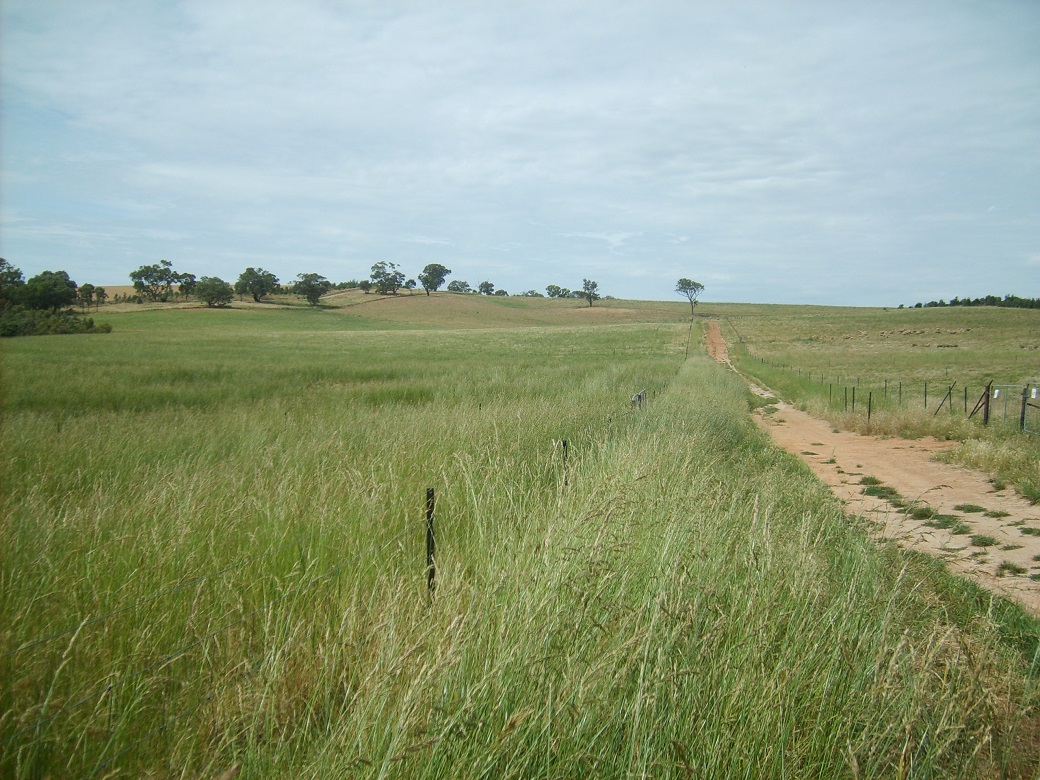
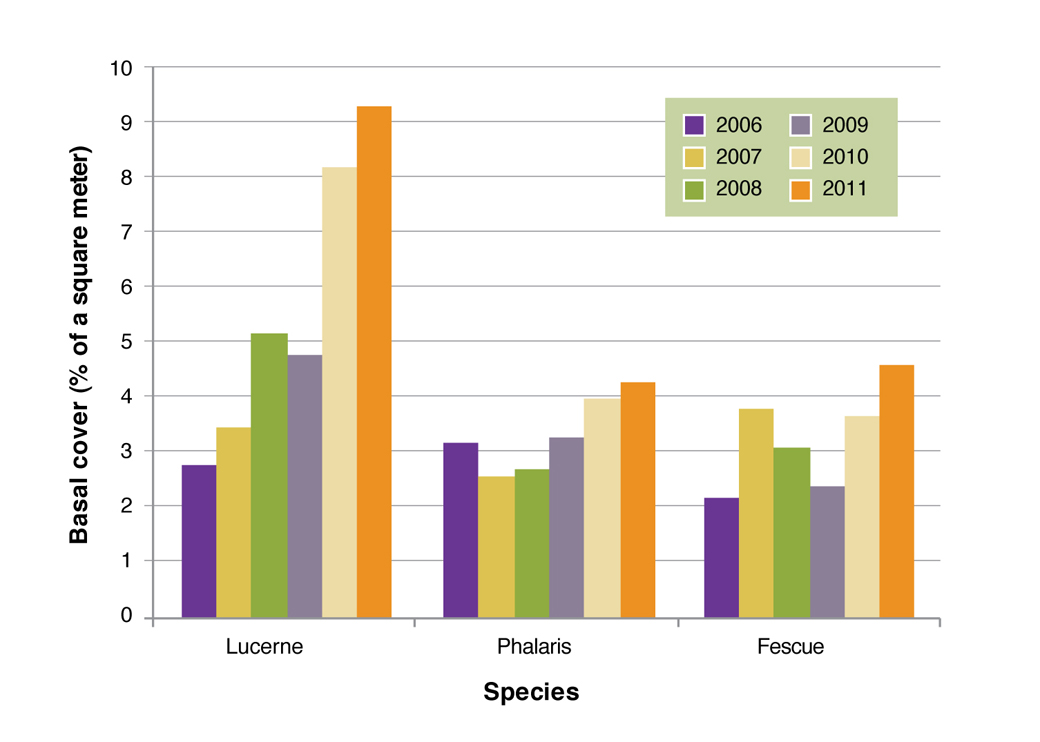
Livestock system had minimal effect on persistence
The basal cover of fescue was similar for all livestock systems. Livestock systems were associated with small (2%) differences in basal cover in lucerne and phalaris pastures. The minimal effects of livestock systems on basal cover (persistence) show that use of suitable grazing management can lead to long-lived pastures despite large differences in stocking rates.
Sub-clover seed declined in the drought
Subterranean clover set little or no seed in 2006-2009 due to lack of spring rainfall, so that the clover content of all pastures declined. Phalaris and fescue pastures were renovated by over-sowing subterranean clover later in the experiment, resulting in a marked increase in sub clover content in 2010.
Annual grasses increased with time
The annual grass content of pastures increased over time and was similar in all livestock systems. Herbicides were used in the lucerne paddocks to control barley grass prior to seed set thereby preventing animal health issues and providing a quality lucerne pasture for weaning lambs.
Ground cover maintained most of the time
Groundcover was maintained above 70% most of the time in all pasture types and did not differ between livestock systems. However, lower groundcover was more likely in lucerne pastures during autumn (Figure 4). Low groundcover in autumn 2007 was partially caused by a heavy rainfall event washing loose plant material down slope.
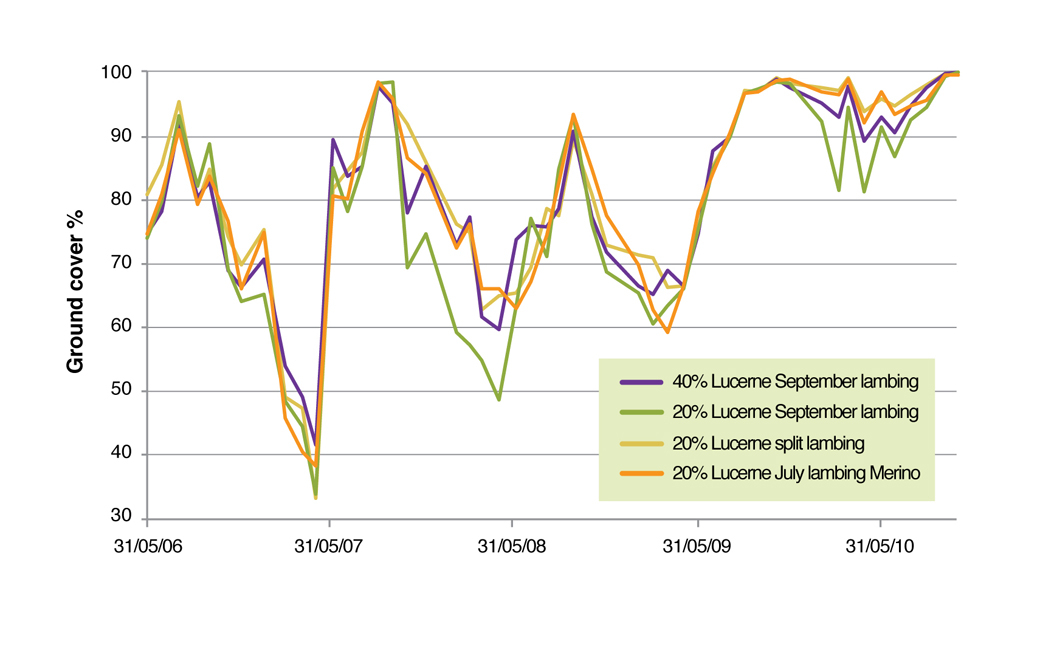
Putting the research into practice
The cost of establishing pastures is high and long term persistence is essential to recoup this cost. Achieving persistent and productive perennial pastures is a result of careful plant selection and placement as well as correct management.
Choose the right mix of species and cultivars based on sound evidence, preferably trial results from an area with similar climate and soils. See EverGraze Actions on growing and using phalaris, summer active tall fescue, summer dormant tall fescue and lucerne for further information on managing establishing and managing these species. Selecting a livestock enterprise that best matches the feed supply will minimise overgrazing, and reduce supplementary feeding costs and the need to destock pastures when conditions deteriorate.
The research shows that relatively simple grazing rules that balance animal and plant needs can effectively contribute to pasture persistence. These rules reflect general recommendations for ground cover (>70%) and herbage mass benchmarks promoted by EverGraze and flagship grazing training programs such as Prograze ™.
In very dry seasons it may be necessary to confine livestock and hand feed to protect the pasture. A properly designed drought lot will help substantially. The cost of hand feeding is also high and other alternative actions, such as agistment or selling of livestock, need to be very carefully considered. The cost of these actions need to then be compared to the losses incurred if the pasture is damaged or needs to be resown.
Further information is available on Managing perennials for persistence and ground cover in the southern slopes NSW, northeast Victoria and upper southwest Victoria region. Also see EverGraze notes on Pastures for place and purpose, On-Farm Options for Grazing Management, the Broadford Grazing Experiment; and the Hamilton EverGraze Right Plant Right Place Right Purpose research page.
Crunching the numbers
The financial benefit of replacing annual pastures with perennials and sowing different pasture species will vary. A Pasture Improvement Calculator is available for producers to estimate the costs and benefits of pasture improvement for individual circumstances.
Long-term simulation modelling was used to examine the benefit of replacing 20% of the annual pasture area of a farm with lucerne or phalaris-based pasture, based on the Wagga Wagga Proof site. If the annual pasture was productive with growth rates similar to that of the perennials (ie. with a good clover and quality annual grass base), stocking rate could not be increased, there was no increase in lamb weights or wool production and the increased cost of sowing the perennial meant that gross margins were reduced.
If the existing annual pasture had much slower growth rates than the perennials (ie. poorer quality annual grasses and low clover), they were unable to carry the same stock numbers without very high levels of supplementary feed. Replacing 20% of unproductive pasture with either lucerne or phalaris reduced supplementary feeding, or allowed 18% higher stock numbers to be carried, resulting in higher gross margins. The benefit was larger if a sheep system with the capacity to use the extra feed was used (later lambing with more lambs), as also seen in the More lucerne increases production and profit document.
The benefit of perennials over annuals can be expected to be larger in regions with more reliable summer rainfall, and where perennials have greater ability to extend the period of quality feed. The examples shown do not consider the risk of annual grass seeds on sheep health, wool and carcase value, as the risk will vary with species and sheep management. The examples shown also do not estimate the value of reduced groundwater recharge and erosion control which may be obtained through use of perennials.
Table 1. Mean gross margins for annual pasture, and annual pasture with 20% area sown to either lucerne or phalaris, with a September lambing dual-purpose flock, simulated 1971-2011.
| Breeding ewes/ha | Mean Gross Margin ($/ha) | ||
| Productive annual | 100% annual | 6.4 | 332 |
| 80% annual. 20% phalaris | 6.4 | 317 | |
| 80% annual. 20% lucerne | 6.4 | 320 | |
| Low growth annual | 100% annual | 3.3 | 209 |
| 80% annual. 20% phalaris | 3.9 | 221 | |
| 80% annual. 20% lucerne | 3.9 | 223 |
On-farm experiences
The persistence and performance of a range of pasture species has been examined in EverGraze Supporting Sites and other demonstration sites throughout the Southern Slopes NSW, North East Vic and South West Vic (Upper) regions. The Euroa Producer Demonstration Site is a key example which has been in place for four years and is continuing to measure the persistence and beef production from five perennial grass species including summer dormant tall fescue, phalaris, coloured brome, summer active and summer dormant cocksfoots managed with rotational grazing. To date, the tall fescue and phalaris have been the highest performing species both in terms of persistence and production.
What it all means
Establishing the correct mix of pasture species and applying simple grazing rules that balance the needs of plants and animals can help perennial pastures persist and remain profitable under a range of animal systems. Additionally, it will minimise the risk of erosion and salinity by reducing recharge. However, the removal of sheep from pastures at minimum threshold levels to achieve pasture persistence may result in high feeding costs, particularly when full hand feeding is instigated. These costs need to be compared to alternative strategies in conjunction with potential pasture replacement costs.
Acknowledgements
EverGraze is a Future Farm Industries CRC research and delivery partnership. The Wagga Wagga EverGraze Proof Site team was led by Dr. Michael Friend at Charles Sturt University. An enthusiastic Regional Advisory Group consisting of farmers, consultants, extension officers and CMA staff provided significant input into the direction, management practices and interpretation of outcomes from the experiment and modelling to make them relevant to farmers.
Authors and contributors
Susan Robertson, Charles Sturt University, Wagga Wagga, NSW
Michael Friend, Charles Sturt University, Wagga Wagga, NSW
Kate Sargeant, formally Agriculture Victoria Benalla
Further Information
- EverGraze Exchange: Selecting pastures for place and purpose
- On-Farm Options: Grazing Management
- Hamilton research message: Right Plant Right Place Right Purpose Right Management
- Managing perennials for persistence and ground cover in the southern slopes NSW, northeast Victoria and upper southwest Victoria region
- EverGraze Action: Growing and using Lucerne
- EverGraze Action – Growing and using summer active Tall Fescue
- EverGraze Action – Growing and using winter active Tall Fescue in southern Australia
- EverGraze Action – Grazing Phalaris for production and persistence
- Broadford Grazing Experiment
- More lucerne increases production and profit
- A simple guide for perennial pasture establishment

